View this article text only, or just the images with captions
The Overthrow of the Monarchy
By Pat Pitzer
''Spirit of Aloha,'' May 1994
(The in-flight magazine of Aloha Airlines)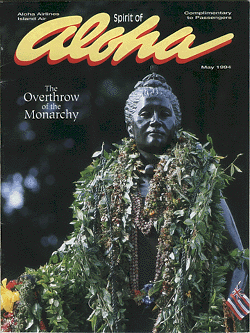
The statue of Queen Lili`uokalani, which stands between `Iolani Palace and the State Capitol, was draped with leis for last year's centennial observance of the overthrow of the Hawaiian monarchy. (Photo by Linda Ching.)
Winds of profound change swept over Hawai`i in the 1890s, turbulent times that altered the islands' future forever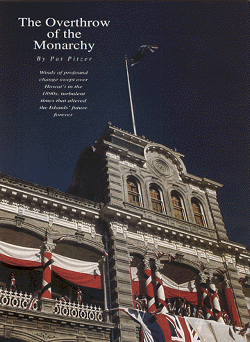
`Iolani Palace , bedecked in Hawaiian flags for King Kalakaua's birthday celebration, proudly recalls the days of Hawai`i's monarchy. (Photo by Brett Uprichard)
Hawai`i entered the decade of the 1890s as a kingdom and emerged from it as a Territory of the United States, with a provisional government and a republic in between. It was a time of monarchs and "mission boys," of royalists, republicans and revolutionaries. The storm that had been gathering broke on Jan. 17, 1893, when the Hawaiian monarchy ended in a day of bloodless revolution. Armed insurrection by a relatively small group of men, most of them American by birth or heritage, succeeded in wresting control of the Islands with the backing of American troops sent ashore from a warship in Honolulu Harbor. To this "superior force of the United States of America," Queen Lili`uokalani yielded her throne, under protest, in order to avoid bloodshed, trusting that the United States government would right the wrong that had been done to her and the Hawaiian people.
Sugar and a coerced constitution played roles in the drama -- intertwined themes of economics and politics.
Sugar was by far the principal support of the Islands, and profits and prosperity hinged on favorable treaties with the United States, Hawaiian sugar's chief market, creating powerful economic ties. As the Islands' sugar industry grew, large numbers of contract laborers were imported first from China, then from Japan and other countries, to work on the plantations -- the beginning of Hawai`i's present multicultural population. Plantation ownership and control of the business community were in the hands of men of American or European blood.
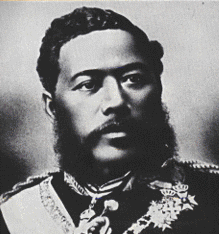
King Kalakaua was forced to sign the Bayonet Constitution in 1887, sharply curtailing his powers and diminishing the Native Hawaiians' voice in government. (Hawai`i Visitors Bureau)
In 1887, during the reign of Lili`uokalani' s brother, King Kalakaua, a group of planters and businessmen, seeking to control the kingdom politically as well as economically, formed a secret organization, the Hawaiian League. Membership (probably never over 400, compared to the 40,000 Native Hawaiians in the kingdom) was predominantly American, including several missionary descendants. Organizer and fire brand of the league was Lorrin A. Thurston, a lawyer and missionary grandson, who would later be a leader in the overthrow of the monarchy, with many of the same men. 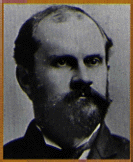
Lorrin Thurston , grandson of American missionaries, was the firebrand behind the revolution against the Hawaiian Monarchy. (Hawai`i State Archives)
Their goal, for now, was to "reform" the monarchy. But reform, like beauty, was in the eye of the beholder. The Native Hawaiians looked up to their sovereigns with respect and aloha. Kalakaua and Lili`uokalani were well-educated, intelligent, skilled in social graces, and equally at home with Hawaiian traditions and court ceremony. Above all, they were deeply concerned about the well-being of the Hawaiian people and maintaining the independence of the kingdom.The league's more radical members favored the king's abdication -- one even proposed assassination -- but cooler heads prevailed. They would allow the king to remain on the throne with his power sharply limited by a new constitution of their making. Dethroning him would be a last resort, if he refused to comply. Many Hawaiian League members belonged to a volunter militia, the Honolulu Rifles, which was officially in service to the Hawaiian government, but was secretly the league's military arm.
Kalakaua was compelled to accept a new Cabinet composed of league members, who presented their constitution to him for his signature at `Iolani Palace. The reluctant king argued and protested, but finally signed the document, which became known as the Bayonet Constitution. As one Cabinet member noted, "Little was left to the imagination of the hesitating and unwilling sovereign, as to what he might expect in the event of his refusal to comply with the demands made upon him."
The Bayonet Constitution greatly curtailed the king's power, making him a mere figurehead. It placed the actual executive power in the hands of the Cabinet, whose members could no longer be dismissed by the king, only by the Legislature. Amending this constitution was also the exclusive prerogative of the Legislature.
The Bayonet Constitution's other purpose was to remove the Native Hawaiian majority's dominance at the polls and in the Legislature. The righteous reformers were determined to save the Hawaiians from self-government.
The privilege of voting was no longer limited to citizens of the kingdom, but was extended to foreign residents -- provided they were American or European. Asians were excluded -- even those who had become naturalized citizens. The House of Nobles, formerly appointed by the king, would now be elected, and voters and candidates for it had to meet a high property ownership or income requirement -- which excluded two-thirds of the Native Hawaiian voters. While they could still vote for the House of Representatives, to do so they had to swear to uphold the despised Bayonet Constitution.
The Hawaiians strenuously opposed the diminution of their voice in governing their own country and resented the reduction of the monarch's powers and the manner in which the Bayonet Constitution had been forced on him. Hawaiians, Chinese and Japanese petitioned the king to revoke the constitution. The self-styled Reform Cabinet responded that only an act of the Legislature could do this - though their new constitution had never been put to a vote.
For the remaining years of the monarchy, efforts to amend or replace the constitution received widespread support. The constitutional controversy proved to be the spark that ignited the overthrow of the monarchy.
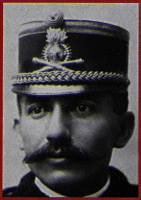
Robert Wilcox led an insurrection in 1889 against the Bayonet Constitution and a counterrevution in 1895 attempting to restore the queen to the throne. (Hawai`i State Archives)
In 1889 a young part-Hawaiian named Robert W. Wilcox staged an uprising to overthrow the Bayonet Constitution. He led some 80 men, Hawaiians and Europeans, with arms purchased by the Chinese, in a predawn march to `Iolani Palace with a new constitution for Kalakaua to sign. The king was away from the palace, and the Cabinet called out troops who forcibly put down the insurrection. Tried for conspiracy, Wilcox was found not guilty by a jury of Native Hawaiians, who considered him a folk hero.
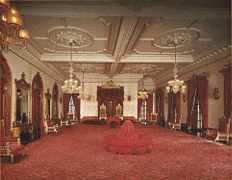
The palace's throne room , once the scene of grand royal balls, later stripped bare as a military court room where Lili`uokalani was tried on treason-related charges, today is once again restored to its former splendor. (Milroy/McAleer for the Friends of `Iolani Palace)
A new constitution would have to be another monarch's responsibility. On Jan. 20, 1891, King Kalakaua died of kidney disease at age 54. He lay in state in the throne room of `Iolani Palace, which during his reign had been the scene of many gala receptions and grand balls. 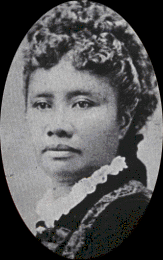 His sister, Lili`uokalani, took the oath of office as monarch, including, to her distaste, swearing to uphold the Bayonet Constitution.
His sister, Lili`uokalani, took the oath of office as monarch, including, to her distaste, swearing to uphold the Bayonet Constitution.
Queen Lili`uokalani yielded her throne under protest, trusting the American government would right the wrong done to her people when U.S. troops backed the revolutionaries. (Hawai`i State Archives)
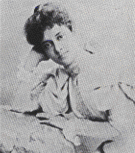
In 1899, six years after the monarchy was overthrown, Princess Ka`iulani , heir to the lost throne, died at age 23. (Bishop Museum)
Like her brother, the new queen was childless. She named as her successor to the throne her niece, Princess Ka`iulani, who was away at school in London.
Lili`uokalani's husband, John Dominis, an American sea captain's son, died just seven months after she became queen.
She would soon face a formidable threat to the monarchy and the independence of the kingdom. In early 1892 Lorrin Thurston and a group of like-minded men, mostly of American blood, formed an Annexation Club, plotting the overthrow of the queen and annexation to the United States. They kept the organization small and secret - wisely, since they were talking treason.
Thurston went to Washington to promote annexation, and received an encouraging message from President Benjamin Harrison: "You will find an exceedingly sympathetic administration here."
In Honolulu, Hawaiians spoke out strongly for their monarchy and presented numerous petitions to the Legislature to replace the Bayonet Constitution, to no avail.
The queen had also been deluged with petitions for a new constitution, signed by an estimated two-thirds of the kingdom's voters, and she boldly prepared to act on their wishes. In her book, Hawai`i's Story by Hawai`i's Queen , she noted, "The right to grant a constitution to the nation has been, since the very first one was granted, a prerogative of the Hawaiian sovereigns."
On Jan. 14, the first of four crucial days in Hawai`i's history, the queen presided at noon over the legislative session's closing ceremonies at the Government Building. She then walked across the street to `Iolani Palace for a more significant ceremony. She was about to proclaim a new constitution which she had written, restoring power to the throne and rights to the Native Hawaiian people.
The Royal Hawaiian Band played as the queen's invited guests, including diplomats, legislators and Hawaiian petitioners, assembled in the throne room, and a large crowd of Native Hawaiians gathered on the palace lawn.
As the audience waited, the queen argued heatedly with her Cabinet, who refused to sign her new constitution, fearing her enemies would use it as a pretext to challenge her. They finally persuaded her to defer action on it.
The queen addressed the guests in the throne room, and the crowd on the palace grounds, telling them that she was ready to promulgate a new constitution, but yielding to the advice of her ministers, was postponing it to some future day.
Alerted earlier of the queen's intention by two of her Cabinet members, the Annexation Club sprang into action. A 13-member Committee of Safety was chosen to plan the overthrow of the queen and the establishment of a provisional government. As they plotted revolution, they claimed that the queen, by proposing to alter the constitution, had committed ''a revolutionary act."
The American warship USS Boston was in port at Honolulu Harbor. With an eye toward landing troops, Lorrin Thurston and two others called upon the American minister in Hawai`i, John L. Stevens, an avowed annexationist. Stevens assured them he would not protect the queen, and that he would land troops from the Boston if necessary "to protect American lives and property." He also said that if the revolutionaries were in possession of government buildings and actually in control of the city, he would recognize their provisional government.
The next day, Jan. 15, Thurston told the queen's Cabinet that the Committee of Safety would challenge her.
In an effort to stave off the mounting crisis, the queen issued a proclamation declaring that she would not seek to alter the constitution except by constitutional means. Unsuccessfully, she sought Minister Stevens' assurance that he would support her government against armed insurrection. The kingdom's marshal proposed declaring martial law and arresting the Committee of Safety, but the Cabinet feared this would lead to armed conflict, and Lili`uokalani wished to avoid bloodshed.
On Jan. 16, several hundred Native Hawaiians and other royalists gathered peaceably at Palace Square in support of the queen, expressing loyalty to the monarchy, and carefully avoiding saying anything inflammatory.
Simultaneously, at the mass meeting called by the Committee of Safety at the armory, the speeches were incendiary. Lorrin Thurston vehemently denounced the queen and asked the crowd to empower the committee to act as it deemed necessary. The resolution passed amid cheers. No one had mentioned overthrowing the monarchy, but the unspoken was apparently understood by all.
The Committee of Safety delivered a letter to Minister Stevens requesting him to land troops from the Boston, stating that "the public safety is menaced and life and property are in peril."
At 5 that afternoon, 162 fully armed troops from the Boston came ashore. A few of the marines were posted at the American Consulate and Legation, but the main body of troops marched through downtown Honolulu past `Iolani Palace. They were quartered less than a block from the Government Building and the palace. While the troops were ordered ashore ostensibly "to protect American lives and property," their placement close to the palace was threatening. Members of the queen's Cabinet hastened to Stevens to protest the troops' presence, but it made no difference.
The Committee of Safety had initially proposed that Thurston head the government, but he said he was considered such a ,"radical mover" it would be better to choose someone more conservative. They then offered the presidency to Sanford B. Dole, another of the "mission boys," as Thurston called them. Dole had declined to take part in the revolution except for drafting documents. Rather than abolishing the monarchy, he favored replacing the queen with a regency holding the throne in trust until Princess Ka'iulani came of age. Still, he accepted the presidency and submitted his resignation as a justice in Hawai`i's Supreme Court.
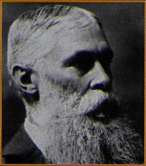
Sanford Dole , who had favored a regency holding the throne in trust for Princess Ka`iulani rather than abolishing the monarchy, became president of the provisional government that replaced it. (Hawai`i State Archives)
On the morning of Jan. 17, Dole gave Stevens a letter from Thurston, asking for his recognition of the provisional government, which they planned to proclaim at 3 that afternoon. The American minister told Dole, "I think you have a great opportunity."
They also had luck. Just as Dole and the Committee of Safety were about to set out to take possession of the Government Building, Hawaiian police halted a wagon loaded with arms for the insurgents, and the driver shot a policeman in the shoulder. (This was the only blood shed during the revolution.) The sound of the shot drew a crowd, including the policemen who had been keeping an eye on the Committee of Safety, and in the confusion, they walked to the Government Building unnoticed.
The building was unguarded and nearly deserted, and few people heard the proclamation that was read from its steps, declaring the end of the monarchy and the establishment of a provisional government as an interim measure until annexation to the United States could be achieved. The American troops were lined up nearby. Minister Stevens immediately, and prematurely, recognized the provisional government.
On Jan. 17, 1893, at dusk, Queen Lili`uokalani yielded her throne under protest, with these words:
"I, Lili`uokalani, by the grace of God and under the constitution of the Hawaiian Kingdom, Queen, do hereby solemnly protest against any and all acts done against myself and the constitutional government of the Hawaiian Kingdom by certain persons claiming to have established a Provisional Government of and for this Kingdom. "That I yield to the superior force of the United States of America, whose Minister Plenipotentiary, His Excellency John L. Stevens, has caused United States troops to be landed at Honolulu and declared that he would support the said Provisional Government.
"Now, to avoid any collision of armed forces and perhaps loss of life, I do, under this protest, and impelled by said forces, yield my authority until such time as the Government of the United States shall, upon the facts being presented to it, undo the action of its representative and reinstate me in the authority which I claim as the constitutional sovereign of the Hawaiian Islands."
The queen surrendered Hawai`i's sovereignty not to the revolutionaries but to the "superior force of the United States of America" -- temporarily, she believed -- confident that the American government would restore her to the throne.
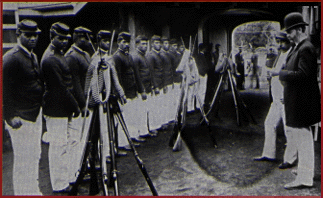
After the queen yielded her authority on Jan. 17, 1893, her Royal Guards surrendered their arms at the palace barracks. (Hawai`i State Archives)
After the queen yielded, the marshal surrendered the police station house, and at the barracks, the Queen's Royal Guards stacked their arms.
Having stated her case in writing, Lili`uokalani retired to her private residence, Washington Place, urging the leaders of her people to avoid riot and to await tranquilly the result of her appeal to the United States government.
The provisional government took over the palace and declared martial law. Later, at its request, Minister Stevens proclaimed Hawai`i a temporary protectorate and raised the American flag over government buildings. He wrote the State Department urging annexation, saying, "The Hawaiian pear is now fully ripe, and this is the golden hour for the United States to pluck it."
The provisional government had chartered a steamer, and Thurston and four others hastened to Washington with a treaty of annexation in hand. The queen's envoys were refused permission to sail on the same ship, and by the time they reached Washington, President Harrison had already sent the annexation treaty to the Senate.
But Harrison was in his last days in power, and Grover Cleveland, who replaced him, withdrew the treaty.
Lili`uokalani wrote to Cleveland requesting redress, and young Princess Ka`iulani went to Washington to appeal for the monarchy and the Hawaiian nation, impressing the president and all who met her with her beauty and dignity.
President Cleveland sent to Honolulu special commissioner James H. Blount, former chairman of the House Committee on Foreign Affairs. Blount's job was to investigate the circumstances of the revolution, the role Minister Stevens and American troops played in it, and to determine the feelings of the people of Hawai`i toward the provisional government.
Blount's instructions were secret, but it was known that his word would be "paramount," concerning the United States in the Islands, so he was given the nickname "Paramount Blount."
He ordered the troops back to their ship and the American flag taken down and replaced by the Hawaiian flag.
Accessible to all who wished to talk to him, he cordially and impartially heard a steady stream of people from both sides. Over four months, he assembled a vast amount of information from interviews, letters and documents.
Blount's final report charged that Stevens conspired in the overthrow of the monarchy, which would not have taken place without the landing of U.S. troops. Blount recommended restoring the queen, saying...The undoubted sentiment of the people is for the queen, against the provisional government and against annexation." He noted, "There is not an annexationist in the Islands, so far as I have been able to observe, who would be willing to submit the question of annexation to a popular vote."
Based on Blount's findings, President Cleveland decided that, in the name of justice, he would do everything in his power to reinstate the queen, provided she would grant amnesty to those who had overthrown her government. The idealistic Cleveland, in assuming the provisional government would willingly relinquish power to her at his request, misjudged the character and tenacity of her adversaries.
The new American minister in Hawai`i, Albert Willis, expressed to the queen the president's regret that the unauthorized intervention of the United States had caused her to surrender her sovereignty, and his hope that the wrong done to her and her people might be redressed. Willis told her the president's condition for reinstating her on the throne was that she grant full amnesty.
Lili`uokalani replied that according to Hawaiian law, the punishment for treason was death, but that she would be satisfied with banishing them from the kingdom forever. Later, she agreed to accede to the president's wishes.
Willis next went to Sanford Dole and the provisional government, assuring them of the queen's amnesty. Speaking for President Cleveland, Willis acknowledged the wrong committed by the United States in the revolution and requested them to resign power and restore the queen.
The answer, of course, was no. They repudiated the right of the American president to interfere in their domestic affairs and said that if the American forces illegally assisted the revolution, the provisional government was not responsible.
On Dec. 18, 1893, President Cleveland made an eloquent speech to Congress on the Hawaiian situation.
He had harsh words for the landing of American troops at the revolutionaries' request:
"This military demonstration upon the soil of Honolulu was of itself an act of war; unless made either with the consent of the government of Hawai`i or for the bona fide purpose of protecting the imperiled lives and property of citizens of the United States. But there is no pretense of any such consent on the part of the government of the queen ... the existing government, instead of requesting the presence of an armed force, protested against it. There is as little basis for the pretense that forces were landed for the security of American life and property. If so, they would have been stationed in the vicinity of such property and so as to protect it, instead of at a distance and so as to command the Hawaiian Government Building and palace. ... When these armed men were landed, the city of Honolulu was in its customary orderly and peaceful condition. ... "
The president continues:
"But for the notorious predilections of the United States minister for annexation, the Committee of Safety, which should have been called the Committee of Annexation, would never have existed. "But for the landing of the United States forces upon false pretexts respecting the danger to life and property, the committee would never have exposed themselves to the plans and penalties of treason by undertaking the subversion of the queen's government.
"But for the presence of the United States forces in the immediate vicinity and in position to accord all needed protection and support, the committee would not have proclaimed the provisional government from the steps of the Government Building.
"And, finally, but for the lawless occupation of Honolulu under false pretexts by the United States forces, and but for Minister Stevens' recognition of the provisional government when the United States forces were its sole support and constituted its only military strength, the queen and her government would never have yielded to the provisional government, even for a time and for the sole purpose of submitting her case to the enlightened justice of the United States. ... "
He further stated,
"... if a feeble but friendly state is in danger of being robbed of its independence and its sovereignty by a misuse of the name and power of the United States, the United States cannot fail to vindicate its honor and its sense of justice by an earnest effort to make all possible reparation."
President Cleveland concluded by placing the matter in the hands of Congress.
The Senate hearings were conducted by the chairman of the Foreign Relations Committee, John Tyler Morgan, an annexationist, whose final report managed to find everyone blameless for the revolution except the queen. Many in the Senate disagreed, and the House censured Stevens and passed a resolution opposing annexation. In the end, Congress took no action either to restore the monarchy or to annex Hawai`i.
With their goal of annexation stalled, the leaders of the provisional government decided to form a republic, while waiting for a more opportune political climate.
They drafted a constitution and declared it law by proclamation -- the very act for which they had forced Lili`uokalani from her throne.
The new constitution required voters to swear allegiance to the republic, and thousands of Native Hawaiians refused, out of loyalty to queen and country. Foreigners who had sided with the revolution were allowed to vote. Property requirements and other qualifications were so strict that relatively few Hawaiians and no Asians could vote.
On July 4, 1894, Sanford Dole announced the inauguration of the Republic of Hawai`i, and declared himself president.
Unwilling to give up, many Hawaiians and other royalists accumulated arms for a counterrevolution to restore the monarchy. In the January 1895 uprising, led by Robert Wilcox, the royalists were forced by government troops to retreat into the valleys behind Honolulu, and after 10 days of fighting, most of them, including Wilcox, were captured.
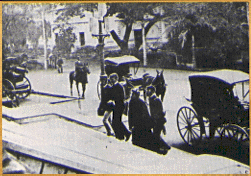
Lili`uokalani is escorted by guards up the steps of the palace, where she was imprisoned after a cache of arms was found in her garden during the counterrevolution of 1895. (Hawai`i State Archives)
The republic's prize catch was Queen Lili`uokalani. A search revealed a cache of arms buried in the flower garden of her home. She was arrested Jan. 16, 1895, exactly two years from the date the American troops landed in support of the revolution. Imprisoned in a corner room on the second story of `Iolani Palace, she was guarded day and night, allowed only one attendant and no visitors.
Shortly after she was imprisoned, Lili`uokalani was given a document of abdication to sign and was led to believe that, if she refused, several of her followers were to be shot for treason. She wrote, "For myself, I would have chosen death rather than to have signed it; but it was represented to me that by my signing this paper all the persons who had been arrested, all my people now in trouble by reason of their love and loyalty toward me, would be immediately released ... the stream of blood ready to flow unless it was stayed by my pen."
Wilcox and four others were sentenced to death, after all. Many other royalists received long prison sentences and heavy fines.
Lili`uokalani noted, ''Their sentences were passed the same as though my signature had not been obtained. That they were not executed is due solely to a consideration which has been officially stated: 'Word came from the United States that the execution of captive rebels would militate against annexation.'"
The queen was charged with misprision of treason -- having knowledge of treason and failing to report it--and was tried by a military commission. Her trial was held in the former throne room of the palace, where she had once greeted sovereigns and dignitaries from around the world. The prosecutors taunted, insulted and tried to humiliate her, but they never succeeded in destroying her dignity.
Found guilty, she was given the maximum sentence of five years imprisonment at hard labor and a $5,000 fine. It was not carried out, but she remained a prisoner in the palace.
On New Year's Day 1896, all the royalist prisoners were freed -- except Lili`uokalani. After eight months of imprisonment in the palace, she was allowed to return to her home, under house arrest. Not until late 1896 was her freedom restored.
She went to Washington, armed with documents signed by many Hawaiians asking President Cleveland to reinstate their queen. The president welcomed her warmly and she expressed her gratitude for his earlier efforts to restore her kingdom's independence. But it was now too late for him to be of further help.
His successor, William McKinley, sent the annexation treaty to the Senate.
Hawaiians submitted a petition to Congress with 29,000 signatures opposing annexation, and petitions to the Republic of Hawai`i, asking that annexation be put to a public vote. They were never permitted to vote on the issue.
Adding to the pro-annexation argument was the outbreak of the Spanish-American War in 1898, drawing attention to the Islands' strategic position in the Pacific.
Ultimately, the annexationists won, and Grover Cleveland wrote: "I am ashamed of the whole affair."
Sovereignty of Hawai`i was formally transferred to the United States at ceremonies at `Iolani Palace on Aug. 12, 1898. Sanford Dole spoke as the newly appointed governor of the Territory of Hawai`i. The Hawaiian anthem, ''Hawai`i Pono `I" -- with words written by King Kalakaua -- was played at the Hawaiian flag was lowered, and replaced by the American flag and "The Star-Spangled Banner." The Hawaiian people had lost their land, their monarchy and now their independence.
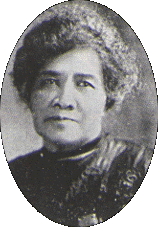 Another loss came the following year, with the death of the beautiful young Princess. Ka'iulani, heir to the Hawaiian throne, at age 23.
Another loss came the following year, with the death of the beautiful young Princess. Ka'iulani, heir to the Hawaiian throne, at age 23.
Lili`uokalani remained an indomitable spirit, honored and revered by her people as a queen to the end. She died in 1917, at the age of 79, still waiting for justice.
A queen to the end to her people, Lili`uokalani died in 1917, her plea for justice unanswered." (Hawai`i State Archives)
Last year, for the observance of the centennial of the overthrow of the Hawaiian monarchy, `Iolani Palace, draped in the black of mourning, was a powerful symbol. The Hawaiian people are still seeking justice through legal means reparations, a fulfillment of trust commitments, settlement of land claims and the return of lands. They are, moreover, seeking recognition of Hawaiian sovereignty. The Native Hawaiians will decide how they choose to structure sovereignty -- as a nation-within-a-nation, complete independence, or some other model. It is no longer a distant dream, but an attainable goal.
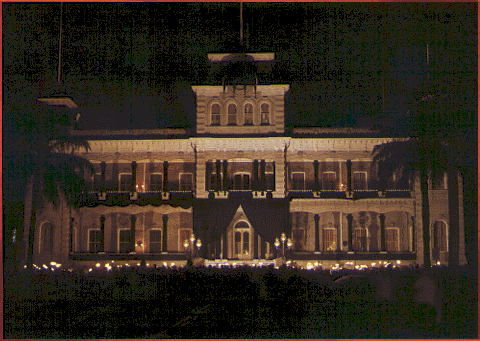
`Iolani Palace , draped in black for last year's observance of the centennial of the overthrow of the monarchy, was a moving, powerful symbol to Hawaiians who participated in a torchlight ceremony.
As a first step toward redressing the wrongs of a century ago, the Hawaiian people have finally received a federal apology, recognition of the American government's participation in the overthrow of the monarchy.
Last November, the United States Congress passed and President Clinton signed a joint resolution saying, "The Congress... apologizes to Native Hawaiians on behalf of the people of the United States for the overthrow of the Kingdom of Hawai`i on Jan. 17, 1893 with the participation of agents and citizens of the United States, and the deprivation of the rights of Native Hawaiians to self-determination;" [and] "... expresses its commitment to acknowledge the ramifications of the overthrow of the Kingdom of Hawai`i, in order to provide a proper foundation for reconciliation between the United States and the Native Hawaiian people."
View this article text only, or just the images with captions
 Return to the Hawaiian Independence Home Page or the News Articles Index
Return to the Hawaiian Independence Home Page or the News Articles Index

 Return to the Hawaiian Independence Home Page or the
Return to the Hawaiian Independence Home Page or the 




 His sister, Lili`uokalani, took the oath of office as monarch, including, to her distaste, swearing to uphold the Bayonet Constitution.
His sister, Lili`uokalani, took the oath of office as monarch, including, to her distaste, swearing to uphold the Bayonet Constitution. 



 Another loss came the following year, with the death of the beautiful young Princess. Ka'iulani, heir to the Hawaiian throne, at age 23.
Another loss came the following year, with the death of the beautiful young Princess. Ka'iulani, heir to the Hawaiian throne, at age 23. 
